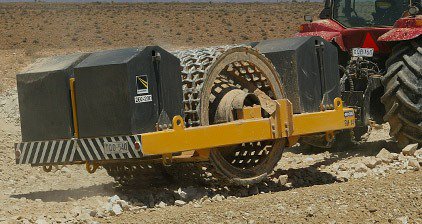Types of roller
Contents[hide] |
[edit] Introduction
Rollers are a type of construction plant used for compacting materials such as soil, gravel, sand, road surfaces and so on. The material can be compacted by vibration, impact loading, kneading, and direct pressure. Different types of roller can be used depending on the requirements of the project and the type of material that needs to be compacted.
[edit] Cylindrical roller
This is a traditional type of roller that is relatively lightweight and can be handled manually or, as was common throughout history, by animals such as oxen or horses. It is usually made of iron, concrete or stone and generally measures around 1 m in diameter and 1.5 m in length. The ground pressure that can be generated by a cylindrical roller is typically around 7 kg/cm2.
[edit] Sheepsfoot roller
Sheepsfoot rollers consist of a steel drum on which round or rectangular protrusions known as ‘lugs’ or ‘feet’ are fixed. There are different types of lug, such as spindle-shaped with widened base, prismatic and clubfoot. Rollers can also be static or vibratory.
The drum’s weight can be increased by ballasting with water, damp sand, or by mounting steel sections.
They are commonly used for compacting fine-grained soils such as heavy and silty clays. They are often used for compacting soils in dams, embankments and subgrade layers in pavements, road and railway projects.
The amount of soil compaction is governed by:
- The weight of the roller.
- The area of each lug.
- The number of lugs in contact with the ground.
- Total number of lugs per drum.
In general, 10 to 20 passes are required to provide complete coverage of the soil, and usually, the top layer of the consolidated soil will need to be finished with a smooth wheel roller.
[edit] Pneumatic tyred roller
Also known as rubber tyred rollers, these consist of a heavily-loaded wagon with several rows of closely-spaced tyres. They provide uniform pressure throughout the width covered, and are often used in pavement subgrade works, as they are suitable for compacting uniform coarse soils and rocks. They are also used to finish embankments compacted by sheepsfoot rollers
The factors which affect the amount of compaction that can be achieved are the weight, tyre inflation pressure and the area of contact.
[edit] Smooth wheeled roller
This type of roller incorporates a large steel drum at the front and one or two wheels or drums at the rear. If there is one wheel at the rear they are known as tandem rollers, and three-wheeled rollers if there are two wheels at the rear.
The weight of a tandem roller ranges from 2-8 tonnes, whereas the weight of a three-wheeled roller ranges from 8-10 tonnes. The ground pressure exerted by tandem rollers is typically around 10-17 kg/cm2.
The performance of a smooth wheeled roller depends on the load per cm width transferred to the soil (which is derived from the gross weight of the drum), and the drum diameter. They are most suitable for consolidating stone, gravel, sand, hardcore and ballast, but are not suitable for embankments, soft subgrades or uniform sands.
[edit] Vibratory roller
This type of roller is fitted with one or two smooth surfaced steel drums measuring 0.9-1.5 m in diameter, and 1.2-1.8 m in width. The drums vibrate by the rotation of an eccentric shaft inside. They are commonly used for compacting granular base courses and sometimes for asphalt, and are useful for compacting to greater depths.
They have higher outputs and improved performance compared to other rollers, but also generally come at a higher cost.
[edit] Grid roller
Grid rollers have a cylindrical heavy steel surface comprising a network of steel bars which form a grid with square-shaped holes. It is common for the roller to be ballasted with concrete blocks. This type of roller is generally a towed unit, and provides high contact pressure but minimal kneading action.
They are typically used for the compaction of well-graded coarse soils and weathered rocks, often in subgrade and sub-base road projects. They are not suitable for clayey soils, silty clays or uniform soils.
[edit] Find out more
[edit] Related articles on Designing Buildings Wiki
Featured articles and news
Retrofit 25 – What's Stopping Us?
Exhibition Opens at The Building Centre.
Types of work to existing buildings
A simple circular economy wiki breakdown with further links.
A threat to the creativity that makes London special.
How can digital twins boost profitability within construction?
The smart construction dashboard, as-built data and site changes forming an accurate digital twin.
Unlocking surplus public defence land and more to speed up the delivery of housing.
The Planning and Infrastructure Bill
An outline of the bill with a mix of reactions on potential impacts from IHBC, CIEEM, CIC, ACE and EIC.
Farnborough College Unveils its Half-house for Sustainable Construction Training.
Spring Statement 2025 with reactions from industry
Confirming previously announced funding, and welfare changes amid adjusted growth forecast.
Scottish Government responds to Grenfell report
As fund for unsafe cladding assessments is launched.
CLC and BSR process map for HRB approvals
One of the initial outputs of their weekly BSR meetings.
Architects Academy at an insulation manufacturing facility
Programme of technical engagement for aspiring designers.
Building Safety Levy technical consultation response
Details of the planned levy now due in 2026.
Great British Energy install solar on school and NHS sites
200 schools and 200 NHS sites to get solar systems, as first project of the newly formed government initiative.
600 million for 60,000 more skilled construction workers
Announced by Treasury ahead of the Spring Statement.
The restoration of the novelist’s birthplace in Eastwood.
Life Critical Fire Safety External Wall System LCFS EWS
Breaking down what is meant by this now often used term.
PAC report on the Remediation of Dangerous Cladding
Recommendations on workforce, transparency, support, insurance, funding, fraud and mismanagement.
New towns, expanded settlements and housing delivery
Modular inquiry asks if new towns and expanded settlements are an effective means of delivering housing.






























